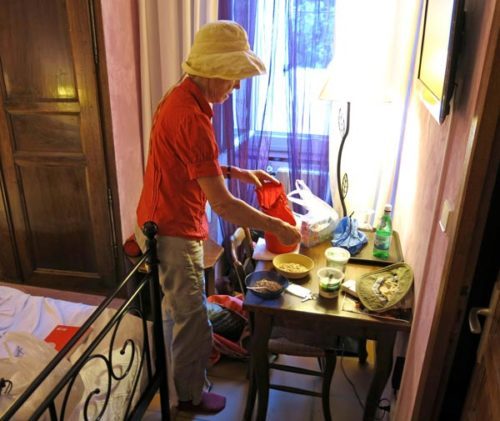
Monday, 1 July 2013
Distance 30 km
Duration 6 hours 40 minutes
Ascent 228 m, descent 281 m
Map 163 of the TOP100 lime-green series
Topoguide (Ref 7000) Le chemin de Régordane
We had told our host the previous evening that we would not be staying for breakfast, as we wanted to set off before the appointed hour of 8 o’clock. In fact we were downstairs by 7 and found him ironing in an ante-room, rather fetchingly dressed in frayed jeans and a T-shirt. We had only seen him formally attired until now.
He led us into the cavernous dining room (seldom used at this time of year) to settle the bill, and took us out through the great front door to point the way to la Rouvière, our immediate destination. From there we would be able to get to la Calmette and rejoin the GR that we had left at Brignon.
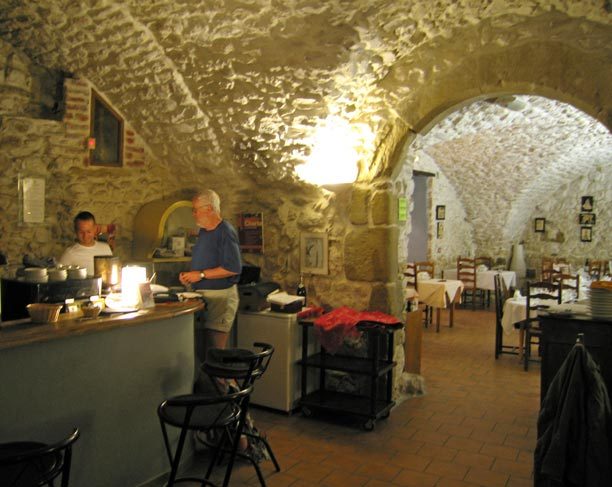
We were pleased that difficulties with accommodation had forced us to come this way, through St-Geniès-de-Malgoirès, instead of on the modern route. It felt more authentic, despite the amount of bitumen that we had trodden. There was also the pleasure of the night in l’Esquielle to be considered.
The countryside was flat and open once we left the confines of the town and we swung along happily towards the knoll of la Rouvière, where the church stuck up like a birthday candle from the top.
When we reached the village we turned up a steep lane, out of curiosity as well as a desire to short-cut the ring road, and found ourselves beside the church, which was small but handsome.
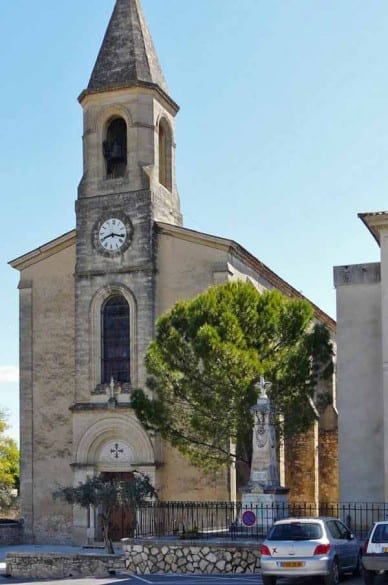
The way down the other side was even steeper and we were soon out in the fields again, on the D210. Just after a bridge over a stream, we picked up a wheel track that was marked as a single black line on the Topoguide map, and that took us delightfully across country in the direction of la Calmette. The only trouble was that the great wall of the newly enlarged N106 blocked our way and we had to creep along beside it until we came to an underpass, and approach the town on a rather busy road.
The main street of la Calmette was being comprehensively dug up at the time. The street was full of barricades, heaps of rubble, heavy machinery and men wielding pneumatic drills. When we came to a bar we went inside but the noise was still deafening. However the TV was giving the drills a bit of competition and we caught up on the latest sports results while sipping our excellent coffee. There was no boulangerie nearby, said the barman, so we did without croissants.
On the way up to the church to join the GR, we were slightly puzzled to see GR marks in the street where no GR should have been (and we had also seen some at the underpass), but we thought it must have been the GR63, not the one we were following, so we were not worried. But we should have been.
The upper part of the town, near the church, was a good example of a mediaeval ‘circulade’ – a village built around a hilltop with a circular layout inside a defensive wall. These circulades were common in the south of France and we were to see others later in our walk.

Following the instructions in the Topoguide, we set out on a quiet road (the old highway) going gently uphill towards the intersection with the N106, where we would cross over onto a forest track.
It was all very pleasant until we got to the crossing point and found that the recent improvements to the highway included a high metal fence all along the edge, completely impregnable. It dawned on us that the route of the GR had changed, which was why we had seen unexpected red and white marks earlier.
We had no choice but to go back down to the outskirts of la Calmette, on a rough track beside the highway.
We did this with bad grace, but eventually found the GR marks and crossed under the hated new road at last.
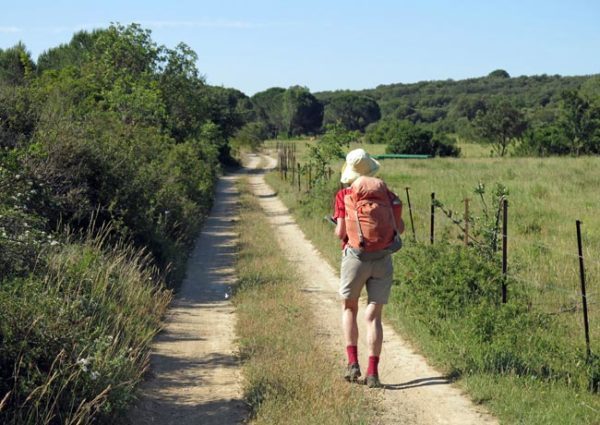
From there we climbed into a dry, scrubby forest of maritime pines, and in due course came to a signpost at the branching off of the GR63.
Under all the signs was a new one, urgently informing us that the route of the GR700 had changed. No doubt there were similar signs in la Calmette, but because we had come in from a different direction and not along the GR, we had missed them.
The rest of the walk into Nîmes presented no problems, apart from the length of time it took to get there. Patches of pine and oak wood were interspersed with great expanses of low, prickly scrub – the typically Mediterranean landscape known as the garrigue.
We plodded through this, not unpleasantly, for what seemed like hours, not really sure where we were on the map because of the re-routing of the track.

We seemed to be trapped in a time-warp, in which we walked and walked but never progressed, a sensation that we had had a few times before in France.
Eventually, when we thought we must be almost at Nîmes, we came to a sign with the dispiriting information that we still had 11.7 km to go. This confirmed our theory about the time-warp.
Another long period elapsed and then we saw houses in the distance across the valley, and the highway coming in from the west (the D907).
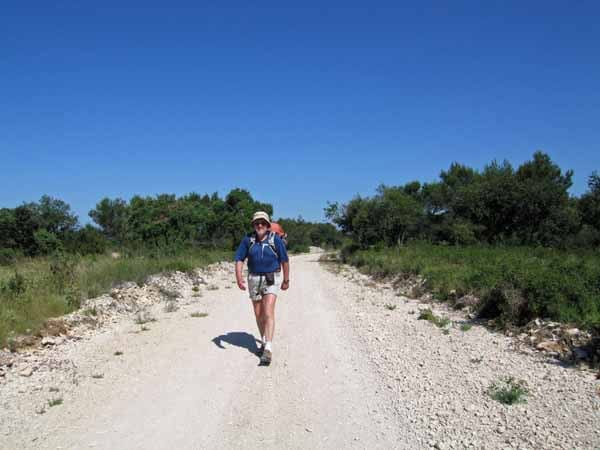
The track descended and crossed the road, then the railway line, and suddenly we were in suburbia, or at least the outskirts of it, with houses on either side, bus-stops, power poles etc.
By now it was 11:30 am and our coffee levels were dangerously low, not having been topped up since 8 am. However there were no shops in sight.
We continued until we came to the western ring road, where great earth works were in train.
Past this, we should have gone into the city park called the Bois des Espeiesses, but there was no GR turning sign so we walked past the entrance, and by the time we realised, we had gone too far to turn back.
Luckily there was a small descending street beside the park, onto which the GR returned at the bottom.
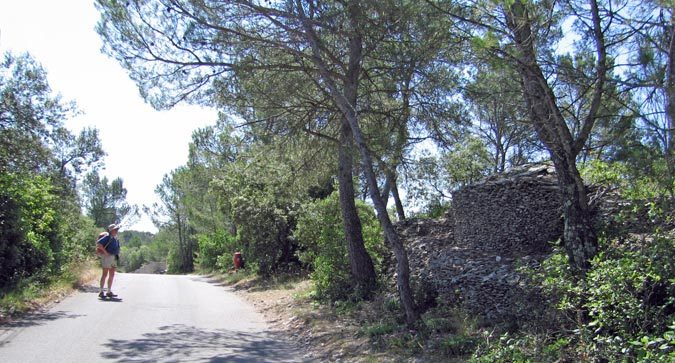
We were now entering the ancient heart of Nîmes, with its famous vestiges of antiquity – the ruins of the Roman ramparts, temple, amphitheatre and water reticulation system.
But we had already seen them on an earlier visit, so instead of taking the GR up a steep path to the heights, we turned right and followed the road down to where we hoped we would find a bar.
We did in the end, but only after trudging past the wall of an impossibly big Protestant graveyard.

With the help of directions from a boulangerie, we found ourselves in a little square off the main street, happily ensconced under an awning outside the Brasserie de l’Aire.
As it was after 1 pm, we got out our lunch food, but put it back uneaten – we were not hungry. On the other hand, we drank litres of cold water with our coffee, some of it left by the previous patrons who had been drinking pastis.
After our morning in the time-warp, it was good to be in the bustle of the town again.
We strolled down a wide avenue of shops, divided in the middle by a row of palm trees, as if to remind us that we were now out of the mountains and into the warmth of the Mediterranean.
This road (the old Route d’Alès) merged into the main avenue leading down from the Temple of Diana and before long we crossed under the railway line and continued going south. Somewhere here we picked up the GR again.
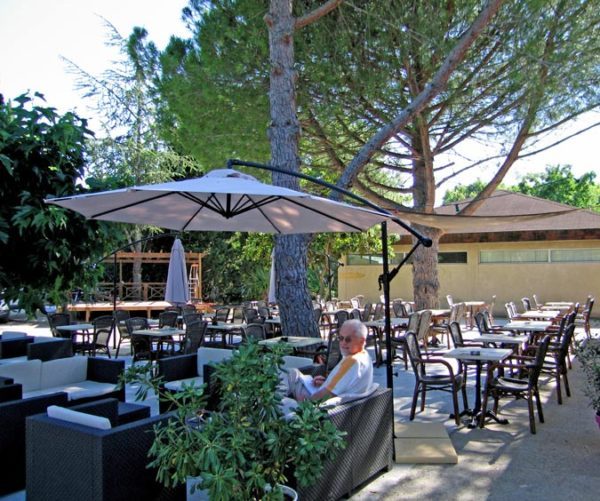
The rest of the day’s walk was entirely on the marked GR, and entirely on the emergency lane of a busy highway. Evidently the designers of the GR had been defeated by the marshy terrain and the need to get over two autoroutes. It was not the most salubrious of walks but after three or four kilometres we were gratified to see the huge sign of the municipal camping of la Bastide on our right.
We cruised in, over a drainage canal, and came to a restaurant with a wide terrace shaded by pines and crammed with tables and chairs as well as padded sofas. It all looked very promising. We paid our €16 and hurried off to set up our tent and have showers before going back for a drink.
It was a very well-set-up place, with a pool, a jumping castle, badminton tables and other amusements as well as the culinary delights that we had already noted. A team of workmen was constructing a wooden stage at one side, for some performance in the future.

There were plenty of caravans and large tents about, but the absence of other walkers was obvious – we had not seen hide nor hair of one since a few hours after leaving la Bastide-Puylaurent, five days ago, and there were no walking tents here except ours. We guessed that they were getting up later than us, and staying in gîtes.
After apéritifs – our standard pastis and glass of rosé – we telephoned our friends in Montpellier to warn them that we would be arriving in two days’ time, then moved from the sofas to a nearby dining table under the trees.
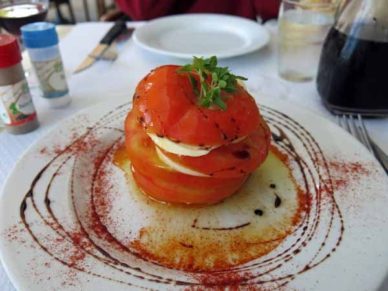
Our first course was a sliced tomato interleaved with mozzarella and drenched in olive oil, whose succulent juices we mopped up with a quantity of excellent bread, the best that we had had for some time.
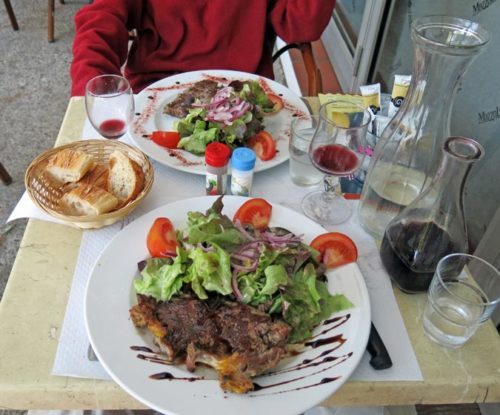
The main meal was our old favourite, steak, accompanied by salad, red wine and more bread.
To finish I had a café crème. It was a simple but delicious meal, made all the more so by the fact that we had no had lunch.
Previous day: Vézénobres to St-Geniès-de-Malgoirès